MP17
| Location: Torrita. | |
| Australian Soil Classification: Epibasic, Petrocalcic, Hypocalcic CALCAROSOL (medium, slightly gravelly, sandy loamy, very shallow). | |
| Northcote Factual Key: Uc 5.22. | Great Soil Group: solonized brown soil. |
| Geology: Quaternary aeolian deposits. | General Landscape Description: Lower slope of a low rise between east-west dunes. |
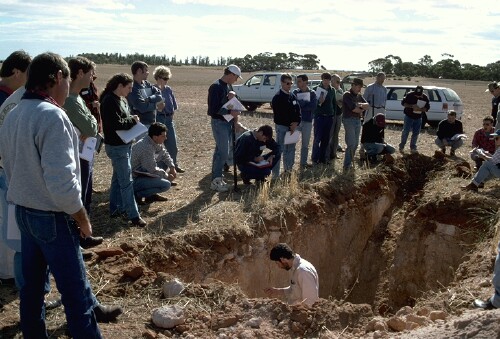 MP17 Landscape |
Soil Profile Morphology:
Surface Soil
| A1 | 0-12 cm | Dark brown (7.5YR4/4); loamy sand; apedal; weak consistence dry; non calcareous; pH 8.4: | 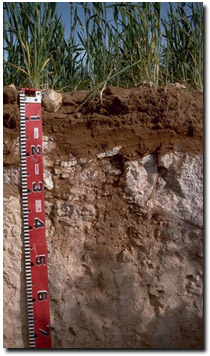 MP17 Profile |
| Subsoil | |||
| B2 | 12-20 cm | Yellowish red (5YR5/8); sandy loam; apedal; very firm consistence dry; slightly calcareous; pH 8.5: | |
| Ck | 20-50 cm | Calcrete layer: | |
| D1k | 50-140 cm | Reddish yellow (5YR6/8); sandy loam (clayey); contains very many (50%) fine-earth carbonates; pH 10.0: | |
| D2 | 140+ cm | Strong brown (7.5YR5/6); light clayey sand; pH 10.1. | |
Key Profile Features:
- Calcrete layer at 25-50 cm depth.
- Accumulation of carbonates in the deeper subsoil.
Soil Profile Characteristics:
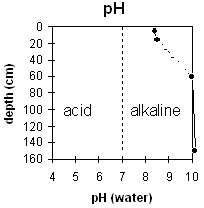 | 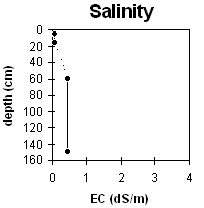 |
The surface soil is moderately alkaline. The deeper subsoil is extremely alkaline from 60 cm. | The surface soil has a very low to low salinity rating. The deeper subsoil has a high salinity rating. |
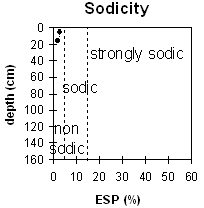 | |
The surface and subsoil are non-sodic. |
Management Considerations:
Whole Profile
- In general, management strategies for all soils should aim to: increase organic matter levels in the surface soil, minimise the degradation of soil aggregates and porosity, promote the development of stable biopores, break up any hardpans, and improve the calcium status of the ion exchange complex. Less frequent tillage, using less aggressive implements, and working the soil at optimum moisture conditions can all assist in maintaining soil aggregation and porosity, as well as reducing the breakdown of organic matter.
- The sandy surface horizon will have rapid water infiltration, slowing down at the less permeable calcrete substrate.
- Plants that do not require a lot of water would be ideal at this site due to the shallow surface soil and sandy texture (low water storage). Most plants would require frequent showers on this soil to survive. However, the low wilting point value indicates that plants will be able to utilise light rains during dry periods by immediately taking up water. Interestingly, the majority of roots are in the surface (A1) 10 cm. Increasing the low levels of organic matter will help to improve these characteristics as well as assist the improvement of aggregation, water holding capacity and fertility.
Subsoil (B) Horizon
- The upper subsoil is non-sodic and moderately alkaline which should present few limitations to plant growth. However, the soil depth to the calcrete layer is quite shallow. This will limit plant available water capacity and effective rooting depth.
Substrate (C) Horizon
- The calcrete layer is highly calcareous and requires calcareous tolerant plants. Water and roots will penetrate this layer only where fractures occur.
Subsoil (D) Horizons
- The deeper subsoil is both extremely alkaline and has a high level of soluble salts.
Comments: At time of sampling MRS were conducting crop trials.
Profile Described By: Mark Imhof, Nabil Badawy and Sonia Thompson (October 1994).


